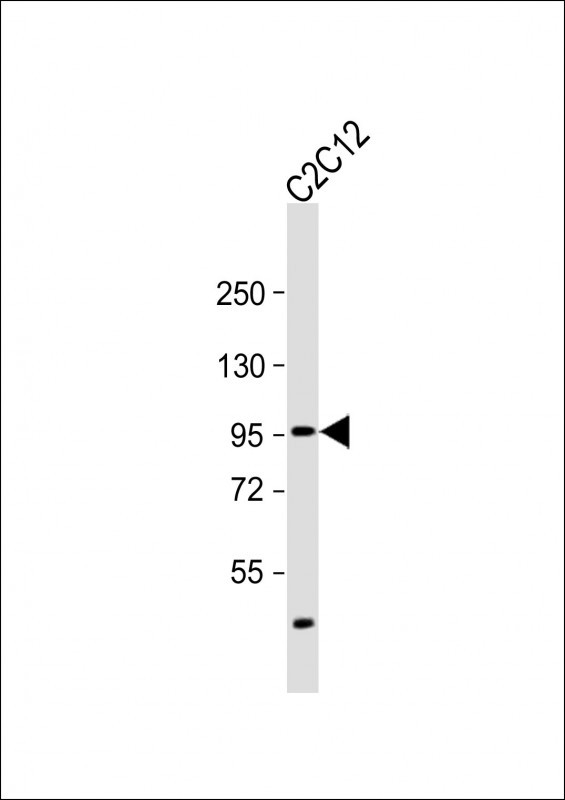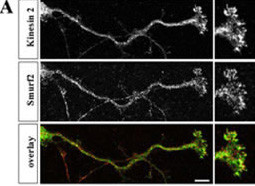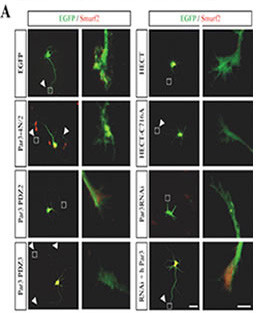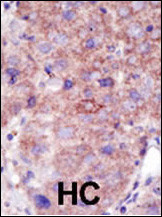




| WB | 1/1000-1/2000 | Human,Mouse,Rat |
| IF | 咨询技术 | Human,Mouse,Rat |
| IHC | 1/100-1/500 | Human,Mouse,Rat |
| ICC | 1/10-1/50 | Human,Mouse,Rat |
| FCM | 咨询技术 | Human,Mouse,Rat |
| Elisa | 咨询技术 | Human,Mouse,Rat |
| Aliases | E3 ubiquitin-protein ligase SMURF2, hSMURF2, 632-, SMAD ubiquitination regulatory factor 2, SMAD-specific E3 ubiquitin-protein ligase 2, SMURF2 |
| Entrez GeneID | 64750 |
| WB Predicted band size | 86.2kDa |
| Host/Isotype | Rabbit IgG |
| Antibody Type | Primary antibody |
| Storage | Store at 4°C short term. Aliquot and store at -20°C long term. Avoid freeze/thaw cycles. |
| Species Reactivity | Human, Mouse, Rat |
| Immunogen | This SMURF2 antibody is generated from rabbits immunized with a KLH conjugated synthetic peptide between 702-731 amino acids from the C-terminal region of human SMURF2. |
| Formulation | Purified antibody in PBS with 0.05% sodium azide,1%BSA and 50% glycerol.prepared by Saturated Ammonium Sulfate (SAS) . |
+ +
以下是关于SMURF2抗体的3篇参考文献及其摘要概括:
1. **"Smurf2 regulates the senescence response and tumourigenesis in a p53-dependent manner"**
- **作者**: Zhang, Y. et al.
- **摘要**: 该研究通过SMURF2抗体检测蛋白水平,发现SMURF2通过泛素化降解p53.调控细胞衰老和肝癌发生,提示其作为潜在癌症治疗靶点。
2. **"Regulation of TGF-β signaling by SMURF2 in pulmonary fibrosis"**
- **作者**: Murakami, G. et al.
- **摘要**: 利用SMURF2抗体进行免疫沉淀实验,证明SMURF2通过靶向TGF-β受体促进其泛素化降解,抑制肺纤维化进展,为抗纤维化药物开发提供依据。
3. **"SMURF2-mediated ubiquitination of BMPR2 regulates mesenchymal stem cell differentiation"**
- **作者**: Yan, X. et al.
- **摘要**: 研究通过Western blot和SMURF2抗体验证,发现SMURF2通过调控BMP信号通路影响间充质干细胞的成骨分化,揭示其在骨代谢疾病中的作用机制。
4. **"SMURF2 promotes cancer metastasis through ubiquitination of E-cadherin"**
- **作者**: Wang, L. et al.
- **摘要**: 使用SMURF2抗体检测肿瘤组织样本,发现SMURF2通过泛素化降解E-钙黏蛋白促进上皮间质转化(EMT),增强乳腺癌转移能力。
这些文献展示了SMURF2在癌症、纤维化及干细胞分化中的关键作用,并涉及抗体在机制研究中的实验应用。
The SMURF2 (SMAD-specific E3 ubiquitin protein ligase 2) antibody is a crucial tool for studying the role of SMURF2. a HECT-domain E3 ubiquitin ligase involved in regulating cellular processes such as protein degradation, signal transduction, and cell homeostasis. SMURF2 primarily targets substrates for proteasomal degradation via ubiquitination, modulating key pathways like TGF-β/BMP signaling, Wnt/β-catenin, and Hippo-YAP. It interacts with SMAD proteins, leading to their ubiquitination and subsequent degradation, thereby fine-tuning TGF-β signaling. Dysregulation of SMURF2 is linked to cancer, fibrosis, and developmental disorders, with roles in promoting tumor metastasis (via EMT) or acting as a tumor suppressor, depending on context.
The SMURF2 antibody enables detection and quantification of SMURF2 expression in tissues or cell lines using techniques like Western blotting, immunohistochemistry, or immunofluorescence. Researchers employ it to investigate SMURF2’s interaction networks, post-translational modifications, and subcellular localization. Its application extends to studying pathological conditions, such as identifying SMURF2 overexpression in certain cancers or its downregulation in aging-related diseases. Recent studies also explore SMURF2’s involvement in autophagy, DNA repair, and viral infection, highlighting its multifaceted biological significance. Reliable SMURF2 antibodies are essential for elucidating its dual roles in oncogenesis and tissue homeostasis, aiding therapeutic target discovery.
×